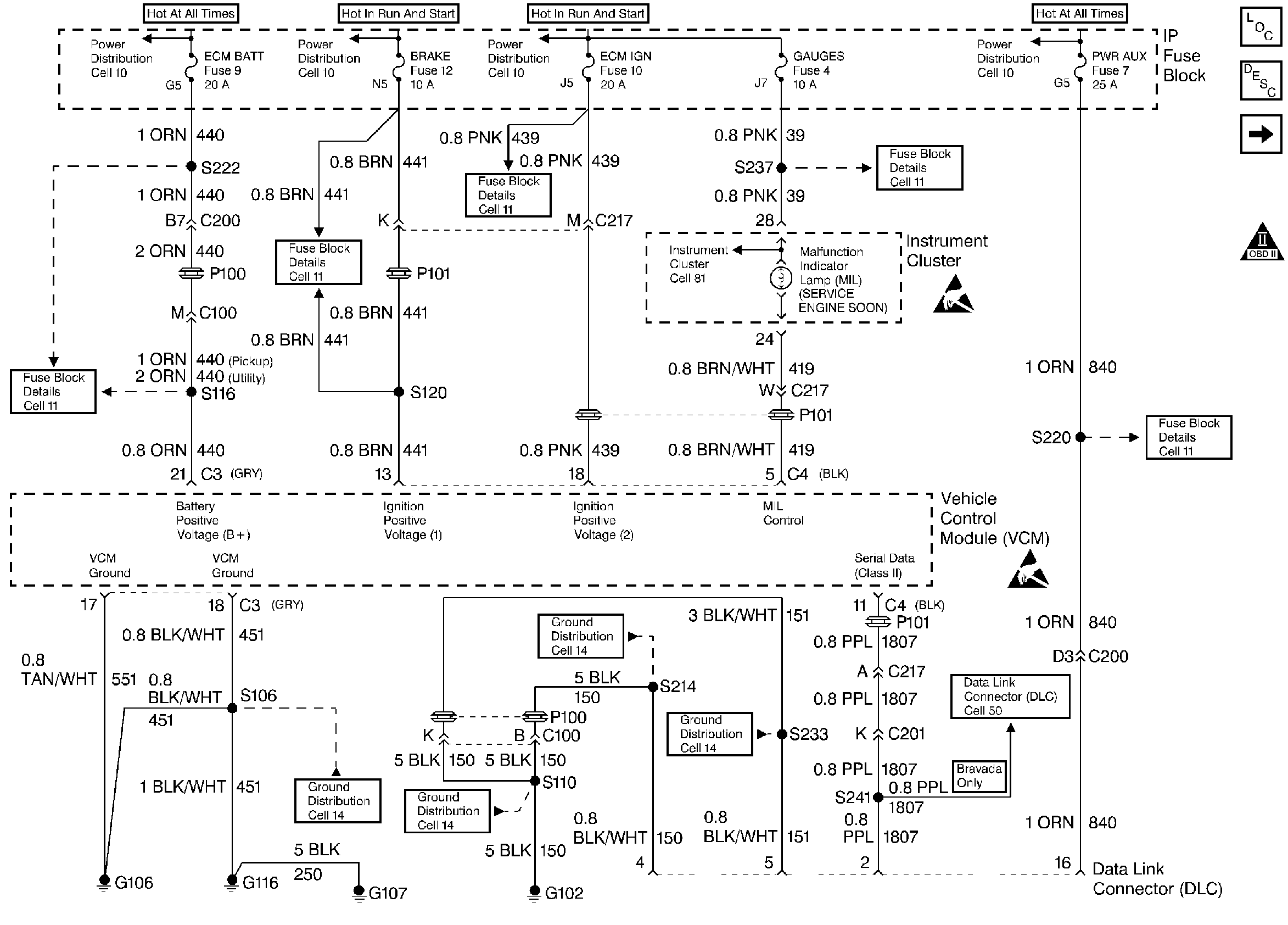Refer to
Instrument Cluster, IP, and the DLC

.
Circuit Description
When the ignition switch is initially turned to the run position, the malfunction indicator lamp (MIL) will be ON steady. When the engine is running and there are no active type A or B DTCs stored, the Vehicle Control Module (VCM) turns OFF the MIL. The ignition switch supplies battery voltage directly to the MIL through the gauge fuse. The VCM controls the MIL by providing a ground path through the MIL control circuit in order to turn ON the MIL.
Diagnostic Aids
An open gauge fuse will cause the entire IP cluster to be inoperative.
Check for any circuitry that is suspected of causing an intermittent complaint for the following conditions:
| • | Backed out terminals |
| • | Improper mating |
| • | Broken locks |
| • | Improperly formed or damaged terminals |
| • | Poor terminal to wiring connections |
| • | Physical damage to the wiring harness |
Test Description
The numbers below refer to step numbers on the diagnostic table.
-
The Powertrain OBD System Check prompts the technician to complete some basic checks and store the freeze frame and the failure records data with the scan tool if applicable. This creates an electronic copy of the data taken when the fault occurred.
-
If the engine fails to start and the MIL is inoperative, then the fault can be isolated to either the VCM ignition feed (ECM-I) fuse, the VCM battery feed (ECM-BATT) fuse, a poor VCM ground at the engine block, or a VCM.
-
A MIL that responds correctly to the scan tool indicates that the fault is not present at this time or that the condition that caused the NO MIL condition is not present.
-
This step isolates a VCM problem from a circuit problem.
-
Locate and repair any shorts that may have caused the fuse to open before replacing the fuse.
-
This step checks the MIL control circuit for a short to voltage.
-
For the MIL replacement procedures, refer to Engine Electrical.
-
For IP replacement, refer to Engine Electrical.
-
The VCM grounds will only cause a problem if all of the grounds are not making a good connection. If a VCM ground problem is suspected, the most probable place to check is where all of the grounds meet at the engine block.
Step | Action | Value(s) | Yes | No |
|---|---|---|---|---|
|
Important: Before clearing the DTCs, use the scan tool to record the Freeze Frame and the Failure Records for reference. This data will be lost when the Clear Info function is used. Was the Powertrain On-Board Diagnostic (OBD) System Check performed? | -- | |||
2 |
Is the MIL ON? | -- | ||
Attempt to start the vehicle. Does the engine start? | -- | |||
Does the MIL turn ON and OFF when commanded? | -- | |||
Is the MIL ON? | -- | |||
Is the MIL ON? | -- | |||
Inspect fuses #9 (ECM-BATT) and #10 (ECM-I) for an open. Are the fuses OK? | -- | |||
8 | Did the fuse in the fused jumper open? | -- | ||
9 |
Is the test light ON? | -- | ||
10 |
Is the action complete? | -- | -- | |
11 | Check for poor VCM connections. Was a problem found? | -- | ||
12 | Repair the open in the VCM ignition feed circuit. Was a problem found? | -- | -- | |
13 | Repair the short to voltage in the MIL control circuit. Is the action complete? | -- | -- | |
14 | Check for an open in the MIL control circuit. Was a problem found? | -- | ||
15 | Check for an open ignition feed circuit. Was a problem found? | -- | ||
Check for an open MIL bulb. Was a problem found? | -- | |||
Replace the IP. Is the action complete? | -- | -- | ||
18 | Probe the battery feed circuit (terminal GRY 21) with a test light connected to ground. Is the test light ON? | -- | ||
Repair the short to ground in the in the MIL control circuit. Is the action complete? | -- | -- | ||
20 | Repair the open in the VCM ignition feed circuit. Is the action complete? | -- | -- | |
21 | Check for a poor VCM ground connection at the engine block. Was a problem found? | -- | ||
22 | Repair the open in the battery feed circuit. Is the action complete? | -- | -- | |
23 | Repair as necessary. Is the action complete? | -- | -- | |
24 | Replace the VCM. Important: When replacing the VCM, the new VCM will need to be programmed. Refer to VCM Replacement/Programming . Is the action complete? | -- | -- | |
25 |
Are there any DTCs displayed? | -- | Go to the applicable DTC table | System OK |
